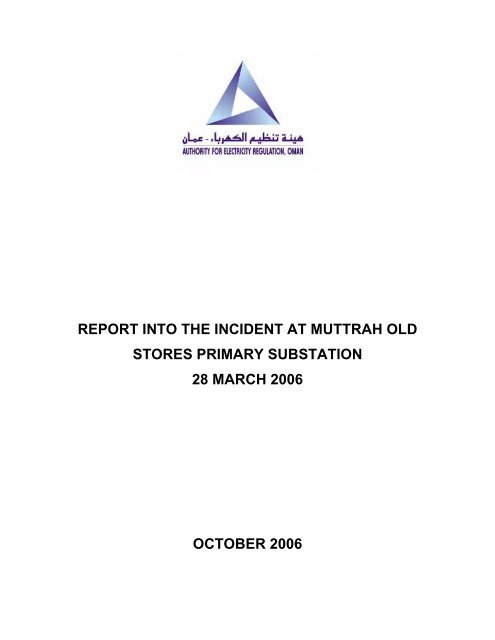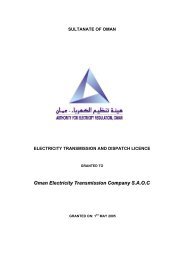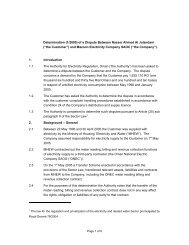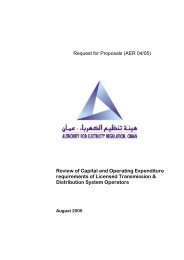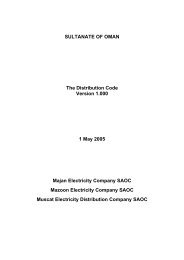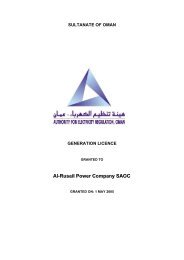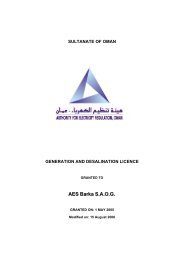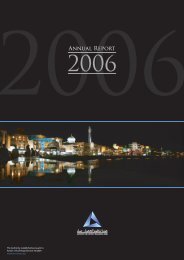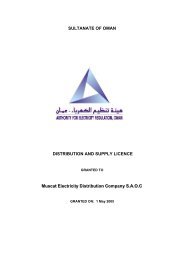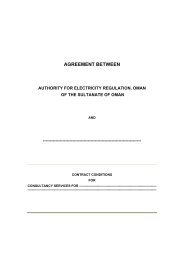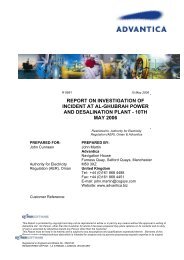2006 Muttrah Incident Report - authority for electricity regulation, oman
2006 Muttrah Incident Report - authority for electricity regulation, oman
2006 Muttrah Incident Report - authority for electricity regulation, oman
You also want an ePaper? Increase the reach of your titles
YUMPU automatically turns print PDFs into web optimized ePapers that Google loves.
REPORT INTO THE INCIDENT AT MUTTRAH OLD<br />
STORES PRIMARY SUBSTATION<br />
28 MARCH <strong>2006</strong><br />
OCTOBER <strong>2006</strong>
TABLE OF CONTENTS<br />
GLOSSARY OF TERMS ..................................................................................................3<br />
1 INTRODUCTION AND SUMMARY OF FINDINGS ..................................................5<br />
1.1 Summary of Findings ..................................................................................................... 5<br />
1.2 Recommendations ......................................................................................................... 6<br />
2 SCOPE OF INVESTIGATION AND METHODOLOGY ............................................7<br />
2.1 Summary of the <strong>Incident</strong> ................................................................................................ 7<br />
2.2 Scope of investigation .................................................................................................... 7<br />
2.3 Methodology................................................................................................................... 9<br />
3 BACKGROUND – RETROFITTING OF SWITCHGEAR........................................10<br />
4 RETROFITTING AT MUTTRAH OLD STORES PRIMARY SUBSTATION...........12<br />
4.1 Substation Design and Layout ..................................................................................... 12<br />
4.2 The Contract <strong>for</strong> Retrofitting at <strong>Muttrah</strong> ....................................................................... 14<br />
5 SEQUENCE OF EVENTS.......................................................................................17<br />
6 TECHNICAL INVESTIGATION...............................................................................20<br />
6.1 The KEMA <strong>Report</strong> ........................................................................................................ 20<br />
6.2 The ABB Italy <strong>Report</strong> ................................................................................................... 25<br />
6.3 Cause of the <strong>Incident</strong> ................................................................................................... 27<br />
6.4 Technical Conclusions ................................................................................................. 28<br />
7 THE CONTRACT....................................................................................................30<br />
7.1 Placing of the Contract................................................................................................. 30<br />
7.2 The Contract – Conclusions......................................................................................... 31<br />
8 SITE SAFETY .........................................................................................................32<br />
8.1 Use of Limitation of Access.......................................................................................... 32<br />
8.2 Conclusions – Site Safety ............................................................................................ 32<br />
9 FIRST AID...............................................................................................................34<br />
10 RECOMMENDATIONS.......................................................................................35<br />
10.1 Retrofitting .................................................................................................................... 35<br />
10.2 Contracts ...................................................................................................................... 35<br />
10.3 Site Safety .................................................................................................................... 35<br />
2
GLOSSARY OF TERMS<br />
The terms defined in this glossary refer specifically to the apparatus/equipment involved<br />
in the incident.<br />
Busbar<br />
An electrical conductor that makes a common connection between several Feeders<br />
or Circuits<br />
Bushing<br />
The insulating material surrounding the fixed Busbar and Feeder Contacts in the<br />
Cubicle.<br />
Circuit Breaker<br />
A device designed to open a Circuit either by manual action <strong>for</strong> the purpose of<br />
isolation or by automatic action when current exceeds a value larger than permitted.<br />
Contacts<br />
Junction of electric conductors. The female Contacts (known also as ‘tulips’) on the<br />
Truck engage the male Contacts in the Cubicle when the Circuit Breaker is<br />
Racked-In to the Service Position<br />
Cubicle or Panel<br />
The fixed portion of a Switchboard. Contains the fixed Busbar and Feeder<br />
Contacts together with the protection and metering devices.<br />
Feeder or Circuit<br />
The cable feeding a particular substation or location from a Switchboard<br />
Flashover<br />
An electrical discharge between one phase and another or between one phase and<br />
ground, sometimes referred to as a short circuit.<br />
Insert<br />
The process of pushing the Truck horizontally into the Cubicle<br />
Oil Circuit<br />
Breaker<br />
A Circuit Breaker using oil as the insulating medium<br />
Rack-In<br />
The process of raising the Circuit Breaker to the Service Position with the Feeder<br />
and Busbar Contacts engaged.<br />
Service Position<br />
A Circuit Breaker Truck is in the Service Position when the moveable Contacts<br />
on the Truck are engaged into the fixed Contacts in the Cubicle<br />
3
SF6 Circuit<br />
Breaker<br />
A Circuit Breaker using Sulphur Hexaflouride as the insulating medium<br />
Spouts<br />
Name commonly used to describe the combination of Bushing and Contacts in the<br />
Cubicle.<br />
Switchboard<br />
A Switchboard is <strong>for</strong>med by a collection of Cubicles and their associated Trucks.<br />
Truck or Carriage The moveable portion of a switchboard. Contains the Circuit Breaker and the<br />
Busbar and Feeder moving Contacts.<br />
Vacuum Circuit<br />
Breaker<br />
A Circuit Breaker using a vacuum as the insulting medium.<br />
4
1 INTRODUCTION AND SUMMARY OF FINDINGS<br />
This report presents the findings of a technical investigation undertaken by the Authority<br />
<strong>for</strong> Electricity Regulation, Oman into the incident that occurred at <strong>Muttrah</strong> Old Stores<br />
Primary Substation on Tuesday 28 March <strong>2006</strong> and which resulted in fatal injuries to two<br />
persons.<br />
In the course of the investigation the inquiry met with key personnel of Muscat Electricity<br />
Distribution Company SAOC (MEDC), Al-Wadi Contracting Company (Al-Wadi) and ABB<br />
Arab, the contractors and suppliers involved, the Royal Omani Police and the Public<br />
Prosecutor’s Office. The inquiry team also visited the site of the incident and reviewed<br />
photographic evidence taken by Authority staff and other parties.<br />
The analysis and conclusions presented in this report have been produced in response<br />
to the in<strong>for</strong>mation made available to the inquiry by all the persons and companies<br />
involved in the incident. Throughout the investigation all persons and companies<br />
involved co-operated fully with the investigation and the inquiry team wishes to express<br />
its appreciation of the professional manner in which the recipients handled its inquiries,<br />
which were sometimes of a sensitive and difficult nature.<br />
1.1 Summary of Findings<br />
The inquiry concludes that the most probable cause of the incident was a flashover<br />
between the conductor arms on the circuit breaker truck manufactured by ABB Arab and<br />
the rear feeder shutter on the original Brush cubicle. The evidence presented to the<br />
inquiry attributes this flashover to shortcomings in the design by ABB Arab of the<br />
interface between the truck and the cubicle.<br />
With respect to contractual issues, the inquiry finds that Al-Wadi Contracting Company<br />
was not qualified to bid <strong>for</strong> the <strong>Muttrah</strong> retrofitting contract, and that there<strong>for</strong>e Al-Wadi<br />
Contracting Company should not have been awarded the contract. Furthermore, having<br />
been awarded the contract Al-Wadi Contracting Company failed to ensure that the<br />
5
elevant terms and conditions of their contract with MEDC were passed on to their<br />
supplier ABB Arab.<br />
On site safety the inquiry concludes that the use of a Limitation of Access <strong>for</strong> carrying<br />
out the work was not appropriate given that the VCB/trucks had never been tested in a<br />
Brush cubicle. However the design defects identified in this report would have<br />
manifested themselves in any case irrespective of the site safety precautions taken<br />
1.2 Recommendations<br />
The inquiry makes a number of recommendations in respect of the circumstances<br />
surrounding this incident:<br />
Retrofitting<br />
Further retrofitting of switchgear should not be carried out unless:<br />
• It is carried out by the original equipment manufacturer (OEM); or<br />
• If carried out by someone other than the OEM it shall be subject to testing in the<br />
original cubicle and witnessed by a reputable switchgear test house.<br />
Contracts<br />
Licencees should ensure that:<br />
• When submitting offers, contractors/suppliers comply strictly with all the terms and<br />
conditions of the invitation to tender;<br />
• That all the terms and conditions of a contract (e.g. production of drawings,<br />
certificates etc ) are en<strong>for</strong>ced;<br />
• That close liaison is maintained between the Contracts Department and the field<br />
staff responsible <strong>for</strong> the supervision of the execution of a contract.<br />
Site Safety<br />
Licencees should ensure that:<br />
• A safety risk assessment is carried out <strong>for</strong> all non-routine work on or adjacent to live<br />
equipment. This assessment should be carried out by an HSE specialist not involved<br />
in the proposed work.<br />
6
2 SCOPE OF INVESTIGATION AND METHODOLOGY<br />
2.1 Summary of the <strong>Incident</strong><br />
At 1846 hrs on Tuesday 28 March <strong>2006</strong> on the distribution system of Muscat Electricity<br />
Distribution Company at <strong>Muttrah</strong> Old Stores Primary Substation a flashover occurred on<br />
the Busbar and Feeder spouts of the Al-Harthy/Local Trans<strong>for</strong>mer 11 KV Circuit Breaker.<br />
As a result of the incident two employees of ABB Egypt, sub-contractors to Al-Wadi<br />
Company were severely burnt and subsequently succumbed to their injuries in Khoula<br />
Hospital on Sunday 2 April <strong>2006</strong>.<br />
2.2 Scope of investigation<br />
As a result of the incident the Authority <strong>for</strong> Electricity Regulation, Oman (the ‘Authority’)<br />
set up a technical inquiry with the following Terms of Reference:<br />
To enquire into the technical circumstances surrounding the fatal accident that occurred<br />
at Old <strong>Muttrah</strong> Stores Primary Substation at 1846 hrs on Tuesday 28 March 2005.<br />
The inquiry shall specifically include the following:<br />
a) The sequence of events that led up to the incident;<br />
b) The safety precautions in place at the time of the incident;<br />
c) The sequence of events following the incident including the provision of first aid to<br />
the injured persons;<br />
d) The specification and scope of the contract <strong>for</strong> retrofitting of vacuum switchgear;<br />
e) The training given to all persons involved in the incident.<br />
7
The inquiry shall be conducted pursuant to the powers granted to the Authority under<br />
Article (22) para (3) of the Sector Law promulgated by Royal Decree No 78/2004 and<br />
shall require any in<strong>for</strong>mation to be provided to it.<br />
The inquiry shall determine the causes of the incident and shall make recommendations<br />
to the Authority <strong>for</strong> any changes in safety procedures and working practices it considers<br />
necessary.<br />
Following the incident the Public Prosecutor’s Office agreed that the Authority’s inquiry<br />
would provide the technical input into its own investigations.<br />
8
2.3 Methodology<br />
In preparing its report the inquiry decided to concentrate on the following aspects:<br />
a) The exact sequence of events leading up to the incident including the safety<br />
precautions in place;<br />
b) The reason <strong>for</strong> the flashover;<br />
c) The actions taken subsequent to the incident;<br />
d) The contract <strong>for</strong> the retrofitting of the Vacuum Circuit Breakers and the quality<br />
assurance aspects of the contract;<br />
e) The experience of the contractor concerned and experience of similar work carried<br />
out in Oman; and<br />
f) The immediate remedial actions required<br />
The inquiry sought independent technical advice from KEMA International and from<br />
Sultan Qaboos University to ensure a rigorous and thorough evaluation of technical<br />
matters. The inquiry also received full cooperation from the ABB Group including the<br />
results of an internal technical review carried out by ABB Italy.<br />
9
3 BACKGROUND – RETROFITTING OF SWITCHGEAR<br />
Many thousands of bulk-oil circuit breakers (OCB) have been in service since the early<br />
1960s and <strong>for</strong>med an integral part of most distribution substations at the 33 KV and 11<br />
KV levels. Many of these circuit breakers are approaching or have exceeded twenty-five<br />
years operational service life. In general, oil-filled switchgear has a proven record of<br />
reliability and per<strong>for</strong>mance. Failures are rare but, where they occur, the results may be<br />
catastrophic. Tanks may rupture, resulting in the ejection of burning oil and gas clouds,<br />
causing death or serious injury to persons and major damage to plant and buildings in<br />
the vicinity of the failed equipment.<br />
Within the Medium Voltage (MV) switchgear sector, there is now increasing interest in<br />
the options <strong>for</strong> the economic replacement of ageing oil based switchgear with switchgear<br />
that utilises non-flammable substances (Vacuum or SF6) as the insulating and breaking<br />
medium.<br />
A typical MV switchboard consists of two parts;<br />
(i)<br />
A fixed portion (‘the cubicle’) containing the busbars, feeder terminations,<br />
protection equipment, voltage and current trans<strong>for</strong>mers etc. The cubicle also<br />
contains the safety shutters which are operated by the action of racking in the<br />
moveable portion.<br />
(ii)<br />
A moveable or withdrawable portion (‘the truck or carriage’) which contains the<br />
circuit breaker itself together with facilities <strong>for</strong> connecting the circuit breaker to the<br />
busbars or feeder circuits.<br />
For the replacement of time-expired switchgear there are two options available:<br />
a) Replace the whole switchboard with one of modern design. This involves the<br />
replacement of both the fixed and moveable portions of the switchboard by modern<br />
equipment. This option is expensive in terms of capital cost: it also requires extensive<br />
10
outages on the distribution system in order to connect the existing feeders to the new<br />
switchboard; or<br />
b) Replace only the moveable portion of the switchboard (‘the truck’) containing the new<br />
circuit breaker. Only minor modifications are normally required to the fixed portion.<br />
This second option is customarily known in the switchgear industry as ‘retrofitting’.<br />
11
4 RETROFITTING AT MUTTRAH OLD STORES PRIMARY SUBSTATION<br />
4.1 Substation Design and Layout<br />
The 11 KV switchboard at <strong>Muttrah</strong> Old Stores Primary Substation is of Brush<br />
manufacture and was installed in the late 1970s. The switchboard consists of two<br />
trans<strong>for</strong>mer bays fed by 16 MVA trans<strong>for</strong>mers from the 33 KV system, a bus coupler bay<br />
and eight feeder bays i.e. it consists of 11 cubicles coupled together. The layout of the<br />
11 KV switchboard is shown in the diagram and photographs below.<br />
FIGURE 1 <strong>Muttrah</strong> Primary Substation Layout<br />
12
FIGURE 2<br />
Brush OCB Truck<br />
removed<br />
<strong>Muttrah</strong> Old Stores 11 KV<br />
Switchboard with the Bus<br />
Coupler OCB truck removed<br />
from its cubicle.<br />
FIGURE 3<br />
Brush OCB Truck<br />
inserted<br />
<strong>Muttrah</strong> Old Stores 11 KV Switchboard<br />
showing the Al-Harthy feeder cubicle with<br />
the original Brush OCB truck in the<br />
inserted position.<br />
13
4.2 The Contract <strong>for</strong> Retrofitting at <strong>Muttrah</strong><br />
In September 2004 the Ministry of Housing Electricity and Water (MHEW) issued an<br />
invitation to tender <strong>for</strong> replacement of the Brush OCBs and trucks at <strong>Muttrah</strong> Old Stores<br />
Primary Substation by modern Vacuum Circuit Breakers (VCB) or SF6 Circuit Breakers<br />
(SCB) on new trucks.<br />
Similar invitations to tender were also issued in respect of Al-Falaj and Al-Wattaya<br />
Substations, which are also of Brush design and with the identical number of cubicles as<br />
<strong>Muttrah</strong>.<br />
Each invitation to tender called <strong>for</strong> the supply and installation of 11 VCBs or SCBs with<br />
their accessories i.e. a total of 33 Circuit Breakers and trucks. For each substation the<br />
contract called <strong>for</strong> the supply of circuit breakers with different current ratings <strong>for</strong> the<br />
isolating contacts:<br />
8 trucks with isolating contacts rated at 400 Amps <strong>for</strong> the feeder circuits<br />
1 truck with isolating contacts rated at 800 Amps <strong>for</strong> the Bus Coupler circuit<br />
2 trucks with isolating contacts rated at 1200 Amps <strong>for</strong> the Trans<strong>for</strong>mer circuit.<br />
The invitation to tender required the tenderer to be a Class D authorised contractor<br />
under the MHEW approved contractor procedure. Tender documents were sold by<br />
MHEW to Al-Wadi Contracting Company despite Al-Wadi being a Class B/C registered<br />
contractor.<br />
Three offers were subsequently received by MHEW:<br />
• Al-Wadi Contracting Company,<br />
• Jyoti Sohar and<br />
• B.E.C.<br />
Al-Wadi Contracting Company proposed to supply retrofit VCB trucks of ABB Arab<br />
manufacture and offered the lowest price. The offers were evaluated and the three<br />
14
contracts were subsequently awarded to Al-Wadi Contracting Company despite that<br />
company not being qualified to bid since it was not a Class D contractor.<br />
Al-Wadi Contracting Company then proceeded to sign two purchase orders with ABB<br />
Arab in Egypt, one <strong>for</strong> the manufacture and supply of the 33 VCB/ trucks and the other<br />
<strong>for</strong> the installation and commissioning.<br />
Although the contract was awarded to Al-Wadi Company in late 2004, the Agreement<br />
was not <strong>for</strong>mally signed by Muscat Electricity Distribution Company (Successor<br />
Company to MHEW) and Al-Wadi until 13 September 2005.<br />
Between the award of the Contract and the signing of the Agreement, a sample Brush<br />
OCB and truck was provided via Al Wadi to ABB Arab. ABB Arab then proceeded with<br />
the manufacture and installation in about April 2005 of a ‘prototype’ VCB truck in the Bus<br />
Coupler cubicle at Al Falaj substation. It has not been possible to find any paperwork<br />
relating to these events.<br />
In January <strong>2006</strong> the 33 VCB/truck assemblies were inspected in Egypt by engineers<br />
from MEDC. In a letter to the Distribution Manager of MEDC the engineers reported:<br />
1. That it was not possible to check the VCB/truck assemblies in a switchgear<br />
cubicle since no such cubicle was available in Egypt and that only mechanical<br />
and insulation tests on the truck assembly were carried out;<br />
2. That the VCBs themselves had been type-tested in ABB Italy and the Test<br />
Certificates had been provided; and<br />
3. That the VCB/truck assemblies had been provided without the female isolating<br />
contacts (‘tulips’). In this context the MEDC engineers suggested ‘in<strong>for</strong>ming ABB<br />
and his agency that it’s not allowed to use any part of the existing Brush circuit<br />
breaker and fixed it in the new VCB….’<br />
The VCB/truck assemblies <strong>for</strong> the three Brush type substations were delivered during<br />
March <strong>2006</strong>. It should be noted that all 33 VCB/truck assemblies were delivered with 800<br />
15
Amp isolating contacts. The contracts called <strong>for</strong> the delivery of 24 VCB/truck assemblies<br />
with 400 Amp contacts, 3 with 800 Amp contacts and 6 with 1200 Amp contacts (see<br />
above).<br />
MEDC decided that the retrofitting should commence at <strong>Muttrah</strong> Old Stores Primary<br />
Substation. The following section describes events leading up to the incident. It should<br />
be noted that employees of ABB Arab (ABB) in accordance with the contract between<br />
Al-Wadi and ABB carried out the actual installation work.<br />
16
5 SEQUENCE OF EVENTS<br />
The sequence is based on the correlated evidence of the investigation reports issued by<br />
the Muscat Electricity Distribution Company (MEDC) and interviews with personnel<br />
involved.<br />
• ABB commenced work on site on 26 March <strong>2006</strong>. On 26 & 27 March no work was<br />
carried out on the switchboard itself. The contractor was involved in unpacking and<br />
inspecting the switchgear trucks (including the new vacuum circuit breakers).<br />
• At 0840 hrs on 28 March <strong>2006</strong> Limitation of Access (LOA) No 32152 was issued by a<br />
Senior Authorised Person of MEDC to the supervisor of ABB. The LOA clearly<br />
specifies that the 11KV Cables and Busbars were live. At the time of issue of the<br />
LOA both Sections of the 11 KV Busbar were alive fed from their respective 33/11<br />
KV Trans<strong>for</strong>mers. The following feeder circuit breakers were open but the 11 KV<br />
cables were alive because of back feeding: Darsait, Oman House (on Section 1) and<br />
Gharifa, Al Harthy (on Section 2)<br />
• The work to be carried out as specified on the LOA was:<br />
To replace oil CBs to vacuum CBs <strong>for</strong> the following CBs Oman House, Ghanifa Fdr<br />
and Darsait Fdr. Al Harhty Fdr<br />
• MEDC state that the LOA was issued to the contractor only <strong>for</strong> working on the Circuit<br />
Breaker in the withdrawn position <strong>for</strong> doing the necessary testing and alignments.<br />
MEDC also state that verbal instructions were given to the contractor to in<strong>for</strong>m the<br />
MEDC engineer, after completing his testing and alignments, that he was ready to<br />
rack in the circuit breakers.<br />
• During the testing and alignment of the new circuit breaker trucks in the withdrawn<br />
position ABB determined that the contacts (tulips) on the truck isolating contacts (i.e.<br />
the contacts that engage in the busbar and feeder spouts when the breaker is racked<br />
17
into the service position) were rated at 800 Amps and not 400 Amps as specified in<br />
the contract. ABB decided to remove the 400 Amp contacts from the old Brush OCB<br />
trucks and use them to replace the 800 Amp contacts on the new VCB trucks. In<br />
order to do this it was necessary to machine a total of 100 copper terminals and ABB<br />
staff proceeded to Wadi Khabeer Industrial Area in order to have this machining<br />
carried out. The use of the tulip contacts from the original Brush trucks and the<br />
machining of the copper terminals was not discussed with MEDC and there<strong>for</strong>e was<br />
done without approval.<br />
• MEDC engineers left site at approximately 1500 hrs.<br />
• Subsequently ABB advised that they proceeded to rack in and rack out new VCB<br />
trucks on 3 Feeders: Darsait, Oman House, and Gharifa. The VCB truck on the<br />
Darsait feeder was left racked in and in the service position.<br />
• ABB also advise that the VCB truck associated with the Al Harthy feeder was then<br />
racked in to the service position with the cubicle door open. The VCB itself was in the<br />
open position with its protection inoperative. ABB were preparing to leave site and<br />
were tidying up their tools when at 1846 hrs a flashover occurred inside the Al Harthy<br />
feeder cubicle.<br />
• Two ABB employees were directly in front of the cubicle and received the full <strong>for</strong>ce of<br />
the flashover, which ignited their clothing. They ran out of the substation and the<br />
ABB supervisor assisted by members of the public extinguished the fire on their<br />
clothing.<br />
• The ABB supervisor called the emergency services but there was a delay of some 45<br />
minutes be<strong>for</strong>e the arrival of the ambulance. During this period it is understood that<br />
the injured persons were not given any first aid. Following arrival of the ambulance<br />
the injured persons were taken to Khoula Hospital where they subsequently<br />
succumbed to their injuries.<br />
18
The protection relay indications <strong>for</strong> the flashover (determined subsequently) were:<br />
At <strong>Muttrah</strong> Stores Primary Substation:<br />
On 16 MVA Trans<strong>for</strong>mer 2: Overcurrent, Earth Fault (Red, Blue – Earth)<br />
Both 33 KV and 11 KV Circuit Breakers tripped.<br />
On Al Harthy Feeder: Overcurrent, Earth Fault (Red, Blue – Earth). Auto Reclose<br />
Block. Feeder Circuit Breaker Open.<br />
At Darsait Primary Substation<br />
On <strong>Muttrah</strong> Stores Feeder: Overcurrent, Earth Fault (Red, Blue – Earth), Auto<br />
Reclose Block. 11 KV Circuit Breaker tripped.<br />
19
6 TECHNICAL INVESTIGATION<br />
Following the incident a series of investigations have taken place in order to determine<br />
the probable cause of the incident. These investigations, led by the Authority have<br />
involved personnel from MEDC, Al-Wadi and ABB. The Power Systems Engineering<br />
Department of Sultan Qaboos University also assisted the inquiry. The Authority<br />
engaged the services of KEMA to act as an independent expert and received a copy of<br />
the internal Design Evaluation <strong>Report</strong> from ABB Italy.<br />
The main basis of the technical findings was site inspections carried out by KEMA and<br />
ABB on the failed equipment at <strong>Muttrah</strong> substation, on the ‘prototype’ equipment at Al-<br />
Falaj substation and on the Brush OCB equipment remaining in service. In addition the<br />
‘prototype’ VCB truck, a sample of the final delivered VCB truck and a Brush OCB truck<br />
were taken to ABB Italy <strong>for</strong> the ABB Design Evaluation.<br />
6.1 The KEMA <strong>Report</strong><br />
The KEMA report is reproduced in full at Appendix A.<br />
The <strong>Report</strong> identifies the following damage to the failed VCB truck and Al Harthy cubicle<br />
by arcing:<br />
• 4 out of 6 isolating contacts<br />
• three bushings on the feeder side<br />
• three insulated copper conductors on the feeder side<br />
• one shutter on the feeder side<br />
• copper conductors near three top terminals of vacuum circuit breaker<br />
• copper conductors near two lower terminals of vacuum circuit breaker<br />
• cast resin housing of the vacuum interrupters<br />
• marks of welding on the earth contact on the truck caused by earth fault current<br />
Photographs 3 and 4 show the simulated configuration of the VCB, cable side bushings<br />
and one shutter on cable side.<br />
20
BUSHING<br />
SHUTTER<br />
FIGURE 4<br />
Reconstruction<br />
of configuration<br />
on cable side<br />
COPPER<br />
CONDUCTORS<br />
FIGURE 5<br />
Lower part of<br />
truck with<br />
VCB<br />
VCB<br />
FEEDER<br />
SIDE<br />
TERMINAL<br />
OF VCB<br />
The KEMA report puts <strong>for</strong>ward three hypotheses <strong>for</strong> the cause of the flashover:<br />
1. Hypothesis 1: Initial fault caused by isolating contacts;<br />
2. Hypothesis 2: Initial fault caused by flashover to open shutter due to inadequate<br />
design; and<br />
3. Hypothesis 3: Initial fault caused by flashover to closing shutter.<br />
21
As indicated in the KEMA <strong>Report</strong> it is often not possible in cases of this kind to be<br />
definitive about the causes of the initial fault. On the balance of probabilities KEMA<br />
conclude that Hypothesis 2 is the most likely cause of the fault.<br />
The basis of Hypothesis 2 is that the ABB design of the copper conductors connecting<br />
the isolating contacts to the VCB itself is such that inside the bushings the original<br />
coaxial configuration of the Brush OCB trucks has been replaced by an asymmetrical<br />
configuration, which reduces the air gap between the plastic sleeve of conductor and the<br />
inner side of the bushing to a minimum. The distance of live parts to the shutter has also<br />
been decreased considerably. Diagram 2 below shows a simplified representation of the<br />
decreased air-gap between the shutter/bushing and the isolating contact arms. Tracks of<br />
scratching and even cutting of this contact arm sleeve by the bushing have been found<br />
on other retrofitted breakers of the same type after they had been racked in and out (see<br />
Photograph 5 below).<br />
FIGURE 6<br />
Insulating Sleeve cut by<br />
bushing.<br />
This VCB truck had been<br />
racked in and out of the<br />
service position.<br />
22
FIGURE 7 Truck – Cubicle Interface<br />
This diagram is purely illustrative and is not to scale.<br />
BRUSH OCB TRUCK<br />
The shutter and bushing are<br />
located on the cubicle (fixed).<br />
The contacts and contact<br />
conductor are part of the truck.<br />
Clearance between<br />
shutter & contacts<br />
Shutter<br />
Contact<br />
Bushing<br />
ABB VCB TRUCK<br />
23
Note the decreased clearance between the bushing and the contact conductor on the<br />
ABB VCB truck.<br />
The KEMA <strong>Report</strong> also raises a number of other issues concerning the design of the<br />
retrofit VCB trucks. These other design shortcomings are not thought to be a contributing<br />
cause to the initial fault:<br />
• The construction of the cylindrical part of the moving isolating contact fingers (‘tulip’)<br />
differs from the original Brush design: it is of a different shape (not conical as in the<br />
original) and tightened with non-original bolts (metric instead of imperial thread) and<br />
additional washers. These were the parts machined at Wadi Khabir (see Sequence<br />
of Events above). It was also noted that the original (800 Amp) cylinders were silver<br />
plated: this plating has been removed by the machining. The holes in the copper<br />
conductors <strong>for</strong> mounting the cylindrical part of the isolating contacts are oversized,<br />
probably <strong>for</strong> adjustment purposes. This may affect the contact resistance and thus<br />
the current withstand capability of the isolating contacts.<br />
• The design and construction of the retrofit breaker, supplied as a prototype in 2005<br />
and installed in the Bus Coupler bay at Al-Falaj, differs in several material respects<br />
from those delivered in <strong>2006</strong> e.g.: different dimensions of isolating contacts (400 A<br />
and 800 A), steel truck, VCB, isolator discs, conductors and height of the copper<br />
conductors.<br />
• During the site inspection a new retrofit VCB could not be inserted into the cubicle<br />
because the truck appeared to be stuck against vital parts of the shutter operating<br />
mechanism; pushing further would have damaged this latching mechanism. See<br />
Photograph 7 below.<br />
• An attempt was made to rack in the failed VCB truck in the Al-Harthy feeder bay. The<br />
construction appeared to be very critical, because the gap between the truck and<br />
linkage of the shutter mechanism was less than 1 mm. Racking in with <strong>for</strong>ce and<br />
without careful positioning could have resulted in damage to the operating<br />
mechanism of the shutters. In addition the side plate on which the bracket to activate<br />
24
the shutter mechanism is mounted is much weaker than on the original OCB truck,<br />
which makes the operation of the shutters less reliable.<br />
• After the incident all the retrofit VCB trucks were racked out and replaced by the<br />
original OCBs. After withdrawal of the breaker truck in the Oman House feeder at<br />
<strong>Muttrah</strong> by engineers of MDEC a broken pin of the latching mechanism of one<br />
shutter was found.<br />
FIGURE 8<br />
Interference with<br />
shutter mechanism.<br />
New VCB Truck<br />
Failed VCB Truck<br />
6.2 The ABB Italy <strong>Report</strong><br />
The inquiry was given access to an internal <strong>Report</strong> prepared by ABB Italy. Since the<br />
report was internal to ABB it is not possible to reproduce it here. However the inquiry is<br />
able to summarise the broad findings of the ABB <strong>Report</strong>.<br />
The ABB Italy report identifies the following design deficiencies:<br />
Contact arms<br />
a) The contact arms are not symmetrical in respect of the center of the bushing.<br />
Considering the bending tolerances the contact arms may have interference with the<br />
internal diameter of the bushing.<br />
b) The contact arms are made by a copper bar of rectangular cross section 10x50mm<br />
with the edge radius of 2mm. Such edge radius is not ideal <strong>for</strong> the heat-shrink insulation,<br />
increasing the possibility of damage of the insulation during the assembling, packaging<br />
25
or the transportation. Damage of insulation may also occur due to the interference of the<br />
edge of the bar with the internal diameter of the bushing (see point a).<br />
Support of the tulip contacts<br />
The design of the support of the tulip contacts is correct, as it retains the same shape as<br />
in the original circuit-breaker, but the supports assembled on site (400A contact system)<br />
are not according to the drawing (800A contact system). The assembled shape tends to<br />
reduce the movement of the tulip contacts in comparison with the original solution.<br />
Stability of the truck<br />
The stiffness in the longitudinal direction of the truck of the retrofit solution is comparable<br />
with the original one. Not so <strong>for</strong> the stiffness in the transverse direction: here the<br />
structure is quite flexible while the original truck is more robust. The transverse flexibility<br />
could affect the correct position of the system to operate the shutter, particularly in the<br />
case where the panel floor was not so well leveled.<br />
The design deficiencies noted above are the same as those identified in the KEMA<br />
<strong>Report</strong>.<br />
Circuit-Breaker locating device<br />
In addition to the above, ABB Italy identified a further deficiency relating to the circuit<br />
breaker truck locating device. This device locks the truck in the panel in one of three<br />
positions test, service, and earth. On the original Brush OCB trucks this device is<br />
interlocked to prevent the circuit breaker being racked in when the truck is not in the<br />
correct position; in addition on the Brush OCB truck it is not possible to unlock or move<br />
the truck with the circuit breaker racked in. This interlocking arrangement was not<br />
present on the trucks supplied by ABB Arab. If the operation to lift the circuit-breaker<br />
starts in an incorrect position the shutter could be damaged or not correctly opened.<br />
26
6.3 Cause of the <strong>Incident</strong><br />
Based on the above findings from the site inspections and evaluations by both KEMA<br />
and ABB Italy it is possible to postulate the probable failure mode.<br />
FIGURE 9 Hypothesis of the Failure Mode<br />
After the VCB/truck was racked into the<br />
service position arcing commenced<br />
between the contact arm, the bushing,<br />
the shutter and the top plate of the<br />
cubicle on one of the outer phases on<br />
the feeder side.. This established a<br />
phase-to-earth fault.<br />
Following ionisation of the air a second<br />
earth fault was established across the<br />
bushing of one of the other phases on<br />
the feeder side.<br />
With two earth faults on the feeder side<br />
a two phase short circuit was thus<br />
established. This short circuit arc would<br />
be fed by the feeder current and was<br />
<strong>for</strong>ced downwards (i.e. away from the<br />
source) by the electromagnetic <strong>for</strong>ces<br />
until it jumped to the lower terminals of<br />
the VCB itself.<br />
Extreme ionization now exists in the<br />
area around the six copper conductor<br />
arms. A three phase fault then occurs<br />
on the top terminals of the VCB. This<br />
fault is fed from the busbar with much<br />
higher power and taking at least 1<br />
second to clear on the back-up<br />
protection.<br />
27
FIGURE 10 Contact Damage<br />
The damage found on the isolating<br />
contacts (‘tulips’) is probably due to<br />
improper assembling and design and<br />
thus could not withstand the short circuit<br />
current from the feeder and busbar.<br />
6.4 Technical Conclusions<br />
In an investigation of this type it is not possible to be definitive about the exact cause of<br />
failure. However both the KEMA and ABB Italy <strong>Report</strong>s identify the most probable cause<br />
as a flashover between the conductor arms on the truck and the rear feeder shutter on<br />
the cubicle.<br />
Both reports are coincident in attributing this failure to shortcomings in the design by<br />
ABB Arab of the interface between the truck and the cubicle. Furthermore as indicated in<br />
the report by MEDC engineers, the truck assembly was never tested in a Brush cubicle<br />
which could have identified the design shortcomings prior to installation.<br />
Additional shortcomings in the design and manufacturing of the truck assembly were<br />
also identified in both reports. These shortcomings include:<br />
• Contact support pillars and their machining on-site;<br />
• Low transversal stiffness of the truck which could have affected operation of the<br />
shutter mechanism;<br />
• Inadequate design of the truck position interlocking mechanism.<br />
On the basis of the above findings the inquiry concludes that the prime cause of the<br />
failure at <strong>Muttrah</strong> was poor design by ABB Arab of the interface between the truck and<br />
cubicle. Furthermore there were a number of other design and manufacturing<br />
28
shortcomings in the trucks supplied which calls into question the quality control<br />
procedures of ABB Arab.<br />
29
7 THE CONTRACT<br />
7.1 Placing of the Contract<br />
As indicated in Section 4.2 above the contract <strong>for</strong> retrofitting at <strong>Muttrah</strong> was placed as a<br />
result of an Invitation to Tender issued by the Ministry of Housing, Electricity & Water in<br />
September 2004. Al Wadi Contracting Company submitted their offer on 24 October<br />
2004.<br />
As noted above Al Wadi Contracting Company was not qualified to bid <strong>for</strong> the contract<br />
as it was a registered Class B/C contractor whereas the Invitation to Tender called <strong>for</strong> a<br />
Class D contractor. Al Wadi proposed to supply new VCB/trucks from ABB Arab and<br />
indicated so in their tender.<br />
The three bids received as a result of the Invitation to Tender were passed by the<br />
Tenders & Contracts Department of MHEW to the Transmission & Control Department<br />
<strong>for</strong> technical evaluation. To date the inquiry has not received a copy of the evaluation<br />
carried out by the Transmission & Control Department nor of the award of the Contract<br />
to Al Wadi. Indeed it is unclear whether the Contract was awarded by MHEW or was<br />
awarded by MEDC in their letter of 13 September 2005.<br />
The terms of the ‘sub-contract’ between Al Wadi and ABB Arab are unclear as both ABB<br />
Arab and Al Wadi were unwilling to release details to the inquiry <strong>for</strong> commercial reasons.<br />
ABB Arab has indicated that the agreement between them was in the <strong>for</strong>m of a simple<br />
purchase order and the inquiry concludes that the relevant terms and conditions of the<br />
contract between MEDC and Al Wadi were not passed on to ABB Arab.<br />
In the period between the submission of the offer (October 2004) and the ‘award’ of<br />
Contract (September 2005) MHEW provided a Brush OCB truck to Al Wadi. This<br />
enabled ABB Arab to design and manufacture a prototype VCB/truck and to install it in<br />
the bus-coupler bay at Al Falaj substation around April 2005. Again the inquiry has been<br />
unable to obtain any written evidence of what took place in this period.<br />
30
Subsequent to the incident it emerged that Al Wadi did not hold any insurance <strong>for</strong> the<br />
Contract even though it was an express requirement of the Contract. Discussions with<br />
MEDC have indicated that it was not the practice to require production of Insurance<br />
Certificates until the contractor requested the Advance Payment (normally 10%) under<br />
the contract. This practice has now been changed and contractors are required to<br />
produce such certificates on signing the contract.<br />
7.2 The Contract – Conclusions<br />
Based on it’s analysis of the documentation available the inquiry concludes the following:<br />
• Al Wadi Contracting Company was not qualified to bid <strong>for</strong> the <strong>Muttrah</strong> retrofitting<br />
contract;<br />
• Al Wadi should not have been awarded the contract;<br />
• Al Wadi did not ensure that the relevant terms and conditions of their contract with<br />
MEDC were passed on to ABB Arab;<br />
31
8 SITE SAFETY<br />
8.1 Use of Limitation of Access<br />
As indicated in Section 6 above the work at <strong>Muttrah</strong> substation was being carried out<br />
under a Limitation of Access issued by a duly authorised engineer of MEDC. According<br />
to the Safety Rules of the MHEW (the Rules currently in <strong>for</strong>ce in MEDC) a Limitation of<br />
Access is a <strong>for</strong>m issued and cancelled by a Senior Authorised Person or Authorised<br />
Person specifically authorised to do so, defining the limits and nature of work which may<br />
be carried out in the vicinity of Live apparatus.<br />
Under normal circumstances the use of a Limitation of Access (rather than a Permit to<br />
Work or Sanction <strong>for</strong> Test) <strong>for</strong> the work being carried out at <strong>Muttrah</strong> was perfectly<br />
acceptable. The racking in/out of OCB/trucks with the busbar and feeder alive is<br />
common practice and does not normally require even a Limitation of Access. However in<br />
the particular circumstances of the incident the VCB/trucks were actually being adjusted<br />
to fit and tested in a Brush cubicle <strong>for</strong> the first time. The use of a Permit to Work (with the<br />
busbar and feeder spouts dead) would have been more appropriate. It should be noted<br />
that the incident could still have occurred once the busbar and feeders were made alive<br />
following cancellation of the Permit to Work because of the design defects noted in this<br />
report.<br />
In their report on the incident MEDC state that verbal instructions were given to the ABB<br />
Arab technicians that they were to carry out all adjustments of the trucks in the rackedout<br />
position and that they should in<strong>for</strong>m MEDC when they were ready to rack-in the<br />
breakers. ABB Arab has disputed that these instructions were ever given. Any additional<br />
instructions to be given in respect of a Limitation of Access, <strong>for</strong> example, should be<br />
written on the Limitation. Having said that, the inquiry believes that the presence or not<br />
of MEDC engineers is irrelevant; the design defects would have manifested themselves<br />
whenever the breaker was racked into the service position.<br />
8.2 Conclusions – Site Safety<br />
In respect of site safety precautions the inquiry concludes:<br />
• That the use of a Limitation of Access was not appropriate given that the VCB/trucks<br />
had never been tested in a Brush cubicle; and<br />
32
• That the design defects identified in this report would have manifested themselves in<br />
any case irrespective of the site safety precautions.<br />
33
9 FIRST AID<br />
From the in<strong>for</strong>mation available to the inquiry, no first aid was given to the injured persons<br />
in the immediate aftermath of the incident. The inquiry notes that some 45 minutes<br />
elapsed be<strong>for</strong>e the arrival of the ambulance but does not feel competent to determine<br />
whether this delay had any effect on the ultimate outcome.<br />
34
10 RECOMMENDATIONS<br />
The inquiry makes the following recommendations:<br />
10.1 Retrofitting<br />
Further retrofitting of switchgear should not be carried out unless:<br />
• It is carried out by the original equipment manufacturer (OEM); or<br />
• If carried out by someone other than the OEM it shall be subject to testing in the<br />
original cubicle and witnessed by a reputable switchgear test house.<br />
10.2 Contracts<br />
Licencees should ensure that:<br />
• When submitting offers, contractors/suppliers comply strictly with all the terms and<br />
conditions of the invitation to tender and that they are qualified to submit a tender;<br />
• That all the terms and conditions of a contract (e.g. production of drawings,<br />
certificates etc ) are en<strong>for</strong>ced;<br />
• That close liaison is maintained between the Contracts Department and the field<br />
staff responsible <strong>for</strong> the supervision of the execution of a contract.<br />
10.3 Site Safety<br />
Licencees should ensure that:<br />
• A safety risk assessment is carried out <strong>for</strong> all non-routine work on or adjacent to live<br />
equipment. This assessment should be carried out by an HSE specialist not involved<br />
in the proposed work.<br />
35


